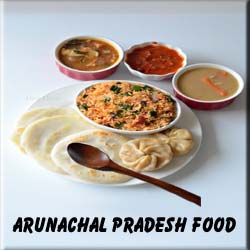CULTURE IS THE ART OF LIVING
The history of Arunachal Pradesh dates back to 1826 during which the Yandaboo treaty was signed. There are no proper records relating to the earlier history for it seems to be very vague and details can be gathered only with oral literature and with some historical ruins found in the foot hills of Arunachal Pradesh during the period of the early Christian era. Initially Arunachal Pradesh was a part of Assam and was more commonly known as the North Eastern Frontier Agency. The ministry of External Affairs initially administered the state of Arunachal Pradesh till 1965 and then the people were governed by the Governor of Assam through the Ministry of Home Affairs. It was only in 1972 it was named as Arunachal Pradesh and deputed as a Union Territory. However in the year 1987 it was constituted as the 24th state of the Indian Union.Most of the people of Arunachal Pradesh are Assamese and they are of tribal origin that follows a distinct culture. During the early 16th century the hilly region of Arunachal Pradesh were inhabited by the Ahom Kings and the area was under their influence and the population were more of Tibeto-Burmese linguistic origin. The tribes of this area adhered and followed the Buddhist ideals.Daflas, Bangnis, the Monpas formed the major part of the population. The Miri along with the Daflas and Tagin lived in the hills. The Apatanis who were agriculturists were considered to be more advanced. The valleys of Arunachal Pradesh were occupied by a group of people and they were commonly known as Adi. Apart from the above mentioned group of people there were smaller groups namely the Membas, Ramos and Boris. There were a minor group of people who were very good in handicrafts and they were the Idus, Taraons, and Kamans. The culture of Arunachal Pradesh can be best expressed as comprising the following:
ORIGIN AND ETHINICITY
Based on the socio-religious affinities, the people of Arunachal Pradesh are classified into three cultural groups. The state of Arunachal Pradesh has a lot of Buddhist temples locally referred to as the 'Gompas'. The people of Arunachal Pradesh are noted for their religious fervour and they maintain and follow strictly the customs and traditions of their religion. The Monpas and Sherdukpens of Tawang and West Kameng districts follow the lamaistic tradition of Mahayana Buddhism. The temples of this area are always richly decorated. The people of Arunachal Pradesh follow terrace cultivation and they are also very much interested in breeding lot of yak and mountain sheeps. The same culture is also followed by another group of tribes living in the mountain ranges of the northern border namely the Membas and Khambas. The eastern part of the state is occupied by the Khamptis and Singphos who have migrated from Thailand and Burma. These people are basically Buddhists who follow the Hinayana sect and still stick to the ancient script. Apart from the Adis, Akas, Apatanis, Bangnis, Nishis, Mishmis, Mijis, Thongsas etc., are those who worship the Sun and the Moon god. Though there are different sects of tribes the ancestors of these groups are Donyi-Polo and Abo-Tani. Since most of them are agriculturists, all their religious rituals and customs are associated with the agricultural cycles. The Noctes and Wanchos tribes are very hardy in nature and maintain a structured village society in which hereditary village chief still plays a vital role.
CULTURE
Apart from its scenic beauty, the Land of the Rising Sun, Arunachal Pradesh has a rich cultural heritage. The rich culture of the state gets its colors from the handicrafts that reveal the expert craftsmanship of artisans. The people of Arunachal Pradesh are generally god fearing and they celebrate lot of festivals accompanied by music and dance. They also have their own set of rituals and customs to be followed on all occassions.Though there are different sects of religions and community, the people of Arunachal Pradesh live in peace sharing their joys and sorrows with each other. The people here are quite friendly and are mostly Tibeto-Burman origin.Atleast 16% of the total population are migrants and there are nearly 20 major tribes and numerous sub-tribes with lot of ethics and customs with different characteristic features. The people of Arunachal Pradesh are divided into three cultural groups namely the first group comprising the Buddhists, while people of the second group practice Donyi Poloism (worship the Sun God and the Moon God) and the third group are those who follow Christianity and Hinduism. Music plays a major part of the culture of the people of Arunachal Pradesh adorned with instruments like drums and cymbals. The songs sung are mainly based on fables related to creatures and animals.Pailibos are folk songs which mainly depict the history and mythology. Baryi is another song in which the history, religious lore and mythology is narrated.
SOCIAL CUSTOMS AND TRADITIONS
The traditions and the customs of the people of Arunachal Pradesh are much influenced by their tribal life for the major population of the state is tribes comprising of about 20 to 26 types. As a part of their tradition they mainly worship the nature deities and as their tribal custom they make animal sacrifices as offerings to their god. Jhumming or shifting cultivation is some of the traditional and primitive form of cultivation. Other traditional cultivation practiced by the Adis and Apatanis are wet rice cultivation and Apatanis are also famous for their paddy-cum-pisciculture.The people of this state are specialized over centuries in harvesting two crops of fish along with each crop of the paddy. The Noctes tribes practice elementary form of Vaishnavism. Every event or occasions and feast like marriages and social gathering are not complete without the singing of the Ja-Jin-Ja special song. It is a must among the boys and girls of the Adi group of tribes to become the members of their respective institutions when they attain the age of ten. After which till the time of the boys' or the girls' wedding will have to remain in their respective dormitories. But however there is no restriction among the boys to visit the girls in their Rashbengs and during such visits if they start liking each other and with the parents' approval marriage takes place following their tribal customs and rituals. Even after the wedding the girl lives with her parents till the birth of her first child, so that in the meanwhile the boy would be able to construct a house to live. In the Adi society descent is traced through the father and the property devolves on the male line and the children belong to the fathers clan.Kebang are those who make important decisions of political and social matters and also settles any disputes among the members of the community. The various kebangs are Bane Kebang, Bango Kebang, Bogum Bokang Kebang and Atek Kebang.
COSTUMES
The most common feature of the tribal costumes is fascinating vibrant colours and myriad patterns. The Monpas women wear a jacket, above a sleeveless chemise. They bind this chemise round their waists with a lengthy and narrow strip of cloth. The women folk of Arunachal Pradesh adorn themselves with silver rings, earrings cut from bamboo-bits and appended with red beads or lovely turquoises. The Tangsa men wear green lungi, proficiently seamed in with matching yellow, red and white yarns. The women usually beautify themselves with big-sized silver earrings and resplendent necklaces, commonly decked with jade. The women also get done involving broad blue stripes painted from the forehead down to the tip of the nose, and five vertical lines, drawn under the lower lip in the chin. Sometime the men also apply tattoo. CUISINE

Thukpa is a kind of noodle soup common among the Monpa tribe of the region. Apong is a refreshing drink which is commonly known as rice beer made from fermented rice or millet. However today the most common food among the people are rice and bamboo soot which is also in great demand in other countries. They are also meat eaters.
OCCUPATION

FAMOUS PERSONALITIES
Tapir Gao -Bharatiya Janata Party (BJP) Member of Parliament (MP).Gegong Apang -Former CM of [Arunachal Pradesh]
Kiren Rijiju -BJP Member of Parliament (MP)
Talom Rukbo -Father of the Donyi-Polo movement Philosophers


